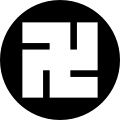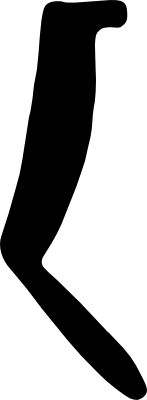Recreational research into Feudal Japan
Posts tagged Sengoku period
Primary Source: Kenmon Shokamon
Jun 5th (a Shakkō (赤口))
O-umajirushi is great for an idea of what mon were like in the Momoyama period, but what were they like before that? There are few earlier sources for mon other than depictions of battle scenes and similar. One that I have found, however, is Kenmon Shokamon (見聞諸家紋), which translates to “Various Observed Family Crests”. It’ss an excellent collection of a wide variety of earlier mon, some of which have been featured on this blog as “provincial samurai” mon. It was originally published around 1467–1470, and it features crests that were observed on the banners and camp curtains of the Ōnin War, which started the Sengoku period.(ja.wp:見聞諸家紋) It contains a variety of combinations and motifs that are rare or absent by the time of the later codifications. I recently got access to the full text of this source via Google Books and shenanigans, and it has plenty of interesting designs, featuring a wide selection of plovers and also including a phoenix, a horse, and a shrimp. It also features some unexpectedly pictorial designs that in some ways are more similar to the later Edo period designs than those in common use around the Momoyama period. Its selection of mon that combine multiple elements in different ways will be useful for those seeking to register mon in the SCA.
I haven’t had time for detailed analysis as of yet, but I present the text for your enjoyment:
Link: O-umajirushi
Jul 19th (a Daian (大安))
Preparing for teaching a class at Pennsic (my first!) on Japanese heraldry, I’ve been gathering some good sources for figures. One of the best primary sources for Sengoku-era heraldry is O-umajirushi, a collection of heraldic displays printed somewhere in 1624–1644. Contrary to some sources, all six scrolls still exist, and I just discovered they can be found online at the National Diet Library of Japan. Enjoy!
Auspicious Days, a dissenting view
Aug 4th (a Daian (大安))
A while back I talked about auspicious days and directions. I recently came upon a counterpoint reflecting the practical aspects of military thought. This is one of the seventeen testaments of Asakura Toshikage, one of the first Sengoku daimyō, the great lords of the Warring States period.(SoJT:429)
It is extremely regrettable if a commander, when fighting a battle that can be won or laying siege to a castle that can be taken, should change his time schedule after choosing an auspicious day and considering which directions are good and which are bad. But if a commander, disregarding auspicious days and favorable directions, assesses in detail the realities of the military situation, lays detailed plans for attacking, responds flexibly to circumstances as they present themselves, and maintains his basic strategy, he is sure to be victorious.
As I’m off to Pennsic War this week, I’ll be sure to follow this advice and completely ignore auspicious days while there. Now, back to packing.
Mon of the Week: Natagama
Jul 4th (a Sembu (先負))
Here we have an interesting mon. Unlike many of the mon we’ve discussed recently, this mon has died out, and is no longer in use. In fact, finding information about this mon at all is quite challenging! It was used by Ōno Harufusa in the Battle of Ōsaka.(SH:62) What do you think it is?
My initial source for this mon, Stephen Turnbull’s Samurai Heraldry, describes this mon as a ‘hatchet’. But it doesn’t look like any hatchet I’ve ever seen. Perhaps this was some sort of traditional Japanese hatchet? Looking into it, however, it seems that Japanese hatchets are pretty similar to Western ones. What then?
After an extensive search, I found the mon in a Japanese collection of Sengoku period mon. Here it is identified as a “nata” (鉈).(SSS) This turns out to be a traditional forestry knife similar to a small machete used by woodcutters and for wilderness survival.(ja.wp:鉈) (The same kanji can also be used to mean “hatchet” in compounds, and a nata can be used for splitting wood like a hatchet, to give Turnbull some credit.) What this mon most resembles, however, is not the ordinary nata, but a variation called a “natagama” (鉈鎌) or “billhook”, which, unlike the plain nata, includes the hook at the end. It is mainly suited for cutting brush and branches, but could also be used as a weapon.(en.wp:Billhook)
As to why this mon didn’t catch on? One possibility is that, straddling the line between a weapon and a tool, once mon representing tools became associated with lower classes it was seen as not suitable for a samurai. Of course, the fact that our friend Harufusa seems not to have had any children(ja.wp:大野治房) may also have something to do with it.
Mon of the Week: Ladder
Jun 7th (a Butsumetsu (仏滅))
As time progressed, the daimyō gained power, and the samurai class came into its own in the Sengoku Period, mon became more universally used for identification among samurai, and the variety of mon used increased. While other forms of identification heraldry were used, including a wide variety of giant objects on poles, mon had the advantage that they could be replicated quickly, used on a wide variety of items (banners, curtains, armor, shields, and personal items), and could be varied easily in color1, background, or placement to represent different divisions of an army.(SH:24) Because of the widespread use of mon and the greater number of surviving records, we have evidence, both written and pictorial, for more mon in the Sengoku and Momoyama periods.
Even as the Edo period approached and mon became more stylistically consistent, they still weren’t as uniform as they later became. For example, while the modern image of mon generally has them about as tall as they are wide, today’s mon doesn’t follow that at all. Then again, it makes sense for a ladder to be tall. Ladders made good mon for several reasons: a simple design, ability to vary rung numbers to create variations, and a shape that mirrored the tall banners often used in battle. It may have also had auspicious connotations of rising in the world.(Dower:118) The ladder mon was used by Makino Tadanari (who used 7 and 10-runged ladders) at the Battle of Osaka in 1614–15 and by Matsudaira (Okochi) Nobutsua (who used an 8-runged ladder) in the Shimbara Rebellion in 1638.2 This latter ladder is shown here.
Here is a modern-style, more square version of the ladder mon. While tall ladders are still in use, they often use a more three-dimensional design than earlier ladders.





